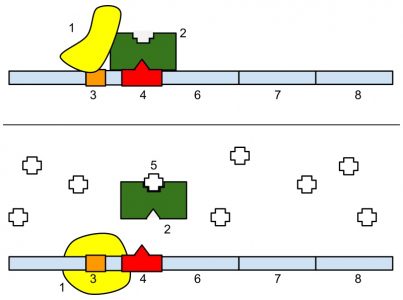Operator Definition
An operator is a genetic sequence which allows proteins responsible for transcription to attach to the DNA sequence. The gene, or genes, which get transcribed when the operator is bound are known as the operon. Repressor proteins, which bind to the gene operator, can block transcription factors from binding to the operator. The function of the operator within genetics is to regulate the production of a certain portion of the DNA.
Operator Function
Not all proteins are needed all the time, yet DNA translation occurs consistently. To prevent a particular protein from being produced constantly, the enzyme which creates mRNA from DNA must be inhibited. If another protein latches onto the DNA, the transcription protein cannot attach to the operator. This can be seen in the following image.
Here, you can see the transcription protein, RNA polymerase, labeled as 1. The repressor protein, labeled 2, is blocking the transcription of the DNA segment. The DNA segment begins with the gene operator, labeled 4. When another chemical, protein, or substance binds to the receptor, it changes form and detaches from the DNA. This allows the RNA polymerase to attach to the DNA segment at the operator sequence. The gene operator will be transcribed, but it will likely be cut out as the mRNA is processed. The remaining DNA segments (6, 7, and 8) contain the information for a protein.
Operators and Gene Regulation
This simple pattern to regulate genes is seen throughout the natural world. Many genes, after the promoter region are followed by a gene operator. This gene operator can have its own repressor protein, which is activated and deactivated by a specific process. Sometimes, it has to do with physical things such as temperature or pressure. Other times, the repressor leaves the operator when a chemical signal reaches the repressor. This allows organisms to express different genes in the face of changing environments and conditions.
An operator can also be activated or deactivated by corepressors, or other proteins or substances which bind to the repressor protein. This makes the repressor undergo a conformational change. Thus, it no longer has the ability to bind to the DNA, and the genes will be transcribed into mRNA and translated into DNA. Usually, this protein will help the organism cope with some stimulus or react to something in the environment.
An operator attached to a gene allows organisms to be much more adaptive. If all organisms expressed all the proteins in their DNA at the same level at all times, they would likely not function. Many proteins are designed for certain times or situations. It would be costly to produce them at all times, and they might also build up and disrupt the normal function of the organism. An operator allows organisms to tightly regulate the production of various proteins, ensuring efficiency as well as adaptability.
References
- Hartwell, L. H., Hood, L., Goldberg, M. L., Reynolds, A. E., & Silver, L. M. (2011). Genetics: From Genes to Genomes. Boston: McGraw Hill.
- Lodish, H., Berk, A., Kaiser, C. A., Krieger, M., Scott, M. P., Bretscher, A., . . . Matsudaira, P. (2008). Molecular Cell Biology (6th ed.). New York: W.H. Freeman and Company.

